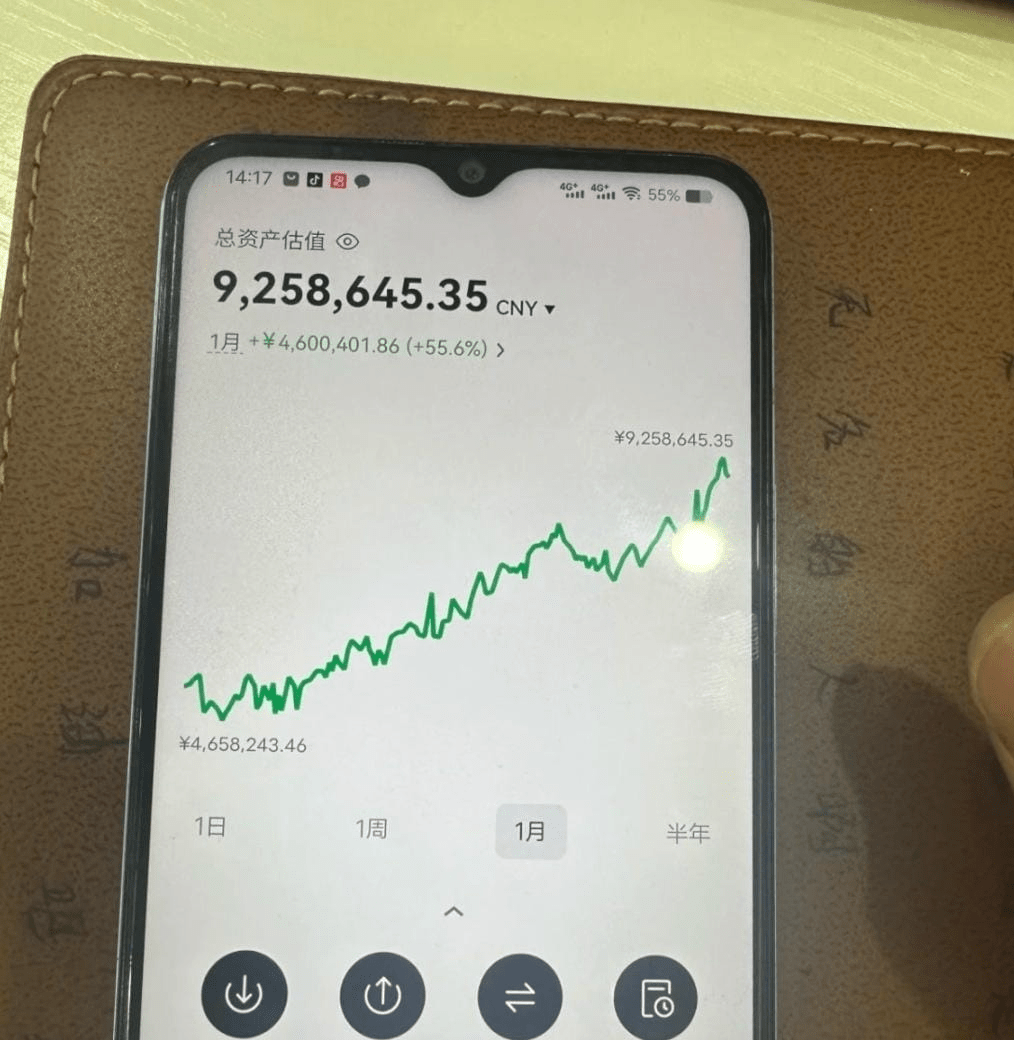Seven years ago, like all newcomers, I watched Bitcoin rise from 789 to 19783, suffering from FOMO (fear of missing out) and plunging in with all my funds, only to see it plummet 40% a week later... But now my investment portfolio has outperformed the market by 470%, and the key is — the manipulation method of rolling positions:
● Increasing positions on unrealized gains: After gaining unrealized profits, consider adding to your position. However, ensure that the holding cost has decreased to reduce the risk of loss. This does not mean blindly adding to your position after making a profit, but rather doing so at the right moment.
● Base position + T-trading strategy: Divide funds into several parts, keep a portion of the base position unchanged, and use another portion for high selling and low buying operations.
The specific ratio can be chosen based on personal risk preference and capital scale. For example, one can choose to roll over half a position, use 30% for the base position, or roll over 70% for the base position, etc. This operation can lower the holding cost and increase profits.
I believe there are mainly two types of 'appropriate timing' defined:
1. Increase positions during convergence breakout trends, eat up the main upward wave after the breakout, and quickly reduce the added position.
2. Increase trend-based positions during pullbacks in the trend, such as buying in batches during moving average pullbacks.
There are many ways to implement rolling positions; the most common is through adjustments in holdings. Traders can gradually decrease or increase their holdings based on market changes to achieve profitability. Traders can also use trading tools like leverage to amplify returns, but this also increases risk.
Three factors to pay attention to in trading:
First, the factor is mindset.
Second, the truth about human nature.
Third, be diligent in learning to enhance your own cognition.

A survival guide for newcomers: How to 'stay alive' in the cryptocurrency market?
✅ Control your positions, leave enough bullets.
Never start by investing all your funds; leave yourself room, and keep ample liquid capital to cope with sudden market changes.
✅ Stay away from high leverage, be cautious with contracts.
Contract trading is extremely risky, especially for newcomers; liquidation is often just a matter of time. Don't be lured by short-term high returns; preserving your principal is key.
✅ Focus on mainstream coins.
Mainstream coins like Bitcoin and Ethereum are relatively stable in volatility and have stronger risk resistance, making them suitable for newcomers to accumulate assets through dollar-cost averaging or long-term holding.
✅ Strictly take profits and stop losses
Greed and luck are the great enemies in the cryptocurrency market. Set reasonable take-profit and stop-loss points, decisively exit when it's time, and do not let profitable positions turn into losses, nor harbor unrealistic fantasies about losing positions.
✅ Always have stablecoins
Keep a certain amount of stablecoins like USDT, USDC, etc., to respond to urgent funding needs, and to quickly enter the market when opportunities arise.
✅ Refuse to chase highs; maintain rationality.
Market opportunities arise every day; missing one is no big deal, but blindly chasing highs is the biggest risk. Stay calm, avoid being swayed by market emotions, and patiently wait for the real opportunity.
Why is it said that trading spot in the cryptocurrency market is at least not easy to lose money, if not a big profit?
As someone who started with 50,000 yuan and achieved financial freedom in the cryptocurrency market, I am increasingly convinced of one fact: If you have enough knowledge about the cryptocurrency market, spot trading is a market where it is extremely difficult to lose money.
Of course, this varies by person. A newcomer may carelessly buy high and trade emotionally, easily leading to losses; but as long as you have experienced two cycles of bull and bear markets and truly understand the market, you will find that spot trading is the real way to make steady profits.
I've been thinking about a question lately: why do most people who make money play spot trading, rather than contracts?
I have summarized the following key reasons:
① Cognitive levels determine trading strategies:
Most people who play spot trading are those who have 'proven their worth' outside the market.
They have substantial funds and are not in a hurry to succeed; they can live well whether there are cryptocurrencies or not.
Thus, being able to hold on and see clearly will prevent you from losing your footing due to short-term fluctuations.
And those who trade contracts often have funds below $100,000, making them prone to emotional imbalance.
Wanting to make a fortune in one step and thinking of multiplying by ten easily leads to starting over from zero.
Leverage trading without risk resistance is essentially gambling.
② Different cycles have vastly different tolerance for error:
Spot trading is a long-cycle investment with a high tolerance for error. No matter how big the pullback, as long as the asset is high quality, there is a high probability that it will return in a few years, or even double.
Contracts are short-cycle trades, with extremely low tolerance for error. The funding rate is high, and the stop-loss point is small; one must judge the direction correctly in a short time, or else it results in a real loss, even leading to liquidation.
③ The psychological pressure gap is immense:
Waking up in the middle of the night, fearing liquidation in my dreams.
Watching the market makes my eyelids twitch, and adding margin feels like paying a 'life insurance'.
And spot trading offers time and freedom:
Sleep when you want to sleep, do what you want to do.
Looking back, I unexpectedly made a lot while 'lying flat'.
So the question arises: how to make steady profits in spot trading?
1. Do 'Understand Before Investing': Don't be an emotional investor.
Many people are heavily invested in Ethereum, and when they see it not rising, they curse — which indicates that they don't understand what they have bought.
You must truly study its mechanism, logic, development path, and core value, and clarify where its long-term growth drivers lie; otherwise, you cannot hold on.
'Don't invest without understanding' is not just a slogan, but the first principle for survival in spot trading.
2. Be patient and wait for the right opportunity: Don't mindlessly chase just because 'it's good'.
Chasing after a good project when it skyrockets will only help others profit.
Real opportunities are always born in low emotional regions.
When others throw it away like a 'hot potato', you dare to catch it steadily.
And not to join in the frenzy when everyone is scrambling for gains.
Investment is not based on emotions, but on cost-effectiveness. A truly excellent hunter knows how to wait for the prey to approach.
In summary:
The core of making money in spot trading is the combination of cognition and timing.
Understanding what you are buying is 'value';
Finding the right entry point is about 'price'.
The combination of both is the chip that transcends bull and bear markets.

A survival guide for newcomers in the cryptocurrency market: First understand these three truths before talking about making money.
1. The essence of the cryptocurrency market: An emotion-driven cognitive battlefield.
The cryptocurrency world is not a 'parallel universe' of traditional finance, but rather a 'cognitive arbitrage game'.
The law of counter-intuitiveness:
✅ Short-term fluctuations are determined by 'stories': A certain AI concept coin surged 500% based on a white paper sketch, with zero progress on implementation, yet retail investors took the bait.
✅ Fund flow > Project value: In 2024, a certain MEME coin's market cap exceeded that of leading DeFi protocols, solely due to the community's strong hype.
Newcomer trap: viewing the cryptocurrency market with a 'stock trading mindset', focusing on financial reports and K-lines while neglecting 'hot narratives', often becoming the 'last buyer'.
2. Technical analysis: Tools ≠ Weapons, Structure > Indicators.
Deadly misconceptions:
❌ Blindly believing 'golden crosses must rise': BTC saw a MACD golden cross in December 2024, only to plummet 15% the next day (big players harvesting from the other side).
❌ Persisting with 'bottom-fishing indicators': Retail investors base their entries on RSI being oversold, unaware that the big players can render indicators 'ineffective' for weeks.
Advanced thinking:
✅ First judge the cycle: Use 'weekly charts to see trends + daily charts to set the rhythm' to avoid blindly 'bottom-fishing' in bear markets.
✅ Look at the funds again: Observe the movement of whale addresses through Glassnode; when whales reduce their holdings for seven consecutive days, any indicator is a 'trap for the greedy'.
3. Ultimate practice: Emotional control > all techniques.
Newcomer's death loop:
Seeing a certain coin soar → buying high (fear of missing out).
A 5% plunge → panic selling (fear of being stuck deep)
Selling at a loss followed by a rebound → anxiety about missing out → chasing heights again.
Data: Binance user research shows that frequent traders have an annualized loss rate of 89%, while users with over 60% of their time in empty positions actually have a higher probability of profit.
Expert survival rules:
✅ Empty position discipline: When the market is flat for over 2 weeks and the hotspots are chaotic, enforce a no-position rule (wait for a 'clear trend').
✅ Emotional anchor point:
Profits exceeding 20% → immediately withdraw 50% of profits to your bank card (breaking the illusion of digital wealth).
Single-day losses exceeding 5% → close trading software and do not operate for 24 hours.
4. Three 'don'ts' advice for newcomers.
Examples of erroneous behavior replacement strategies: chasing hot coins focusing on 'high consensus coins' (BTC/ETH); a certain metaverse coin soared 10 times and then returned to zero, leaving retail investors with nothing; going all in using 'pyramid increasing positions' (adding 20% position after a 10% drop); in 2025 BTC plummeted 30%, those building positions in batches had costs 18% lower than all-in players; following 'group signals' and using 'on-chain data' to verify news (like large transfers on etherscan); a certain community's call for 'institutional accumulation' was actually the big players offloading before luring in the greedy.
Conclusion: The core formula for making money in the cryptocurrency market is 'Cognitive Depth × Emotional Stability'. Before entering, newcomers should ask themselves three questions:
Can I bear the risk of 'losing my principal'?
Am I willing to spend more than three months studying the 'essence of the industry'?
Can I wait 'one month continuously in an empty position' for opportunities?
If the answer is all 'yes', then enter the market with 'rationality'. Remember: this market never lacks 'short-term profiteers', but the ones who last are always the 'emotionally detached' rationalists.
Exploring the world of digital currencies is like understanding the true meaning of life; once you grasp the wisdom of living, the secrets of the cryptocurrency market will also become clear. The path of simplicity lies in the integration of knowledge and action, allowing for smooth navigation and confident success!#上市公司加密储备战略 $BTC


